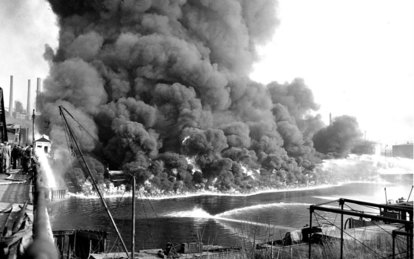Reflections on the Cuyahoga River Fire’s Golden Anniversary

Courtesy of Cleveland Press Collection at Cleveland State University Library
While working with our team on this first Great Lakes Cities publication, Cleveland writer Daniel McGraw penned this piece commemorating the 50th anniversary of the infamous Cuyahoga River fire. The EPA subsequently issued new guidelines for water quality permitting that restrict the ability of state’s to meet the goals of the Clean Water Act – legislation that was inspired by the Cuyahoga fire. The hope for the “lasting effect” of extinguishing that fire is worth holding on to as we work to make sure nothing like it ever happens again.
On Sunday, June 22, 1969, the Cuyahoga River in Cleveland, Ohio caught fire for what was believed to be the 13th time in its history. It is the 50th anniversary of that fire this summer: a fire that changed the view of environmental issues substantially in the U.S. after the firefighters put it out.
The Cuyahoga River in Cleveland, Ohio was like many in the industrial Midwest cities back then — a river long polluted with oily wastes, chemicals, and debris. The river fire, coming at a time of emerging national concern over pollution, made big news weeks after it occurred and became something of a famous disaster. But the irony of it all was that it did not make big news where it occurred.
Two bridges were damaged by the fire. But the local Plain Dealer newspaper did not get any photographers down to shoot the fire, and the story got six paragraphs on page 11 the next day, next to a L’Oreal shampoo ad that was much bigger. “The 1969 fire wasn’t a huge story at first,” Cleveland historian John Grabowski said years later. “But then we started seeing EPA hearings, a rising environmental movement and a big Time Magazine story on the environment that focused on the Cuyahoga River.”
Time Magazine, in its Aug 1, 1969 issue, made the fire into a sort of sick, national joke: “No Visible Life. Some river! Chocolate-brown, oily, bubbling with subsurface gases, it oozes rather than flows. ‘Anyone who falls into the Cuyahoga does not drown,’ Cleveland's citizens joke grimly. ‘He decays.’ The Federal Water Pollution Control Administration dryly notes: ‘The lower Cuyahoga has no visible life, not even low forms such as leeches and sludge worms that usually thrive on wastes.'"
But this fire did have a huge lasting effect. Inspired by the river fire, Congress was determined to resolve the issue of the country’s pollution problems, not just in Cleveland, but throughout the United States. They passed the National Environment Policy Act (NEPA) which was signed into law on January 1, 1970. That then led to establishment of the Environmental Protection Agency (EPA) later that year.
One of the first legislations that the EPA put-forth was the Clean Water Act (1972), which mandated that all rivers throughout the United States be hygienic enough to safely allow mass amounts of swimmers and fish within the water by 1983. Though the rivers’ cleanliness did not meet that deadline, much environmental progress had been made since the fire. And a lot of that progress was forced into the national mindset because of that burning river in 1969.